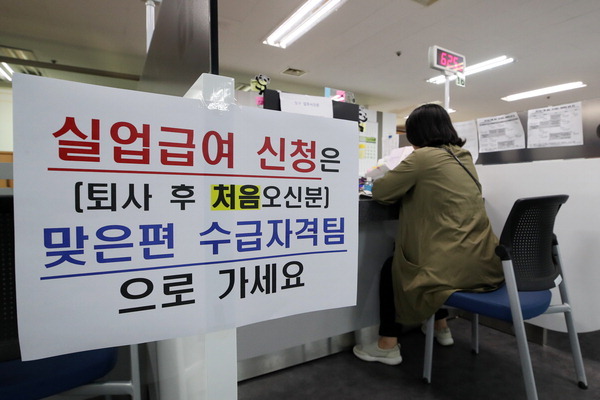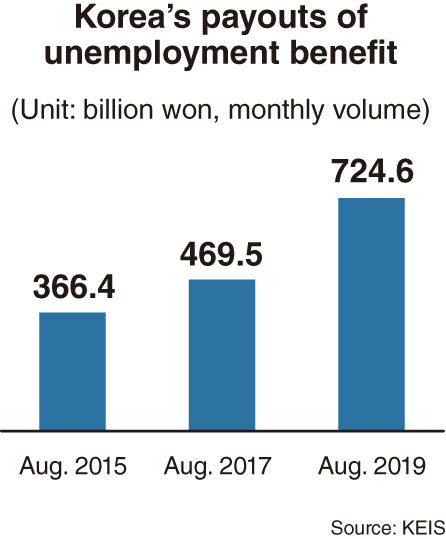[News Focus] Monthly payouts for jobless soar 97% since 2015
By Kim Yon-sePublished : Oct. 10, 2019 - 16:50
SEJONG -- The number of South Koreans, who have been “de facto” out of work, has surpassed the 3 million mark.
The extended unemployment figures, as specified by Statistics Korea’s Employment Supplementary Index III, includes “underemployed” workers, such as temporary employees who work fewer than 36 hours a week and want full-time employment, as well as seasonal workers who are out of work for part of the year.
The standard unemployment rate stayed at 3 percent, with the number of jobless at 858,000, in August. But under the extended basis, the number of de facto unemployed people came to 3.1 million -- or 11 percent of the nation’s 28.21 million economically active people.
The extended unemployment rates have remained above 10 percent since December 2016, and above 11 percent since December 2018.
The extended unemployment figures, as specified by Statistics Korea’s Employment Supplementary Index III, includes “underemployed” workers, such as temporary employees who work fewer than 36 hours a week and want full-time employment, as well as seasonal workers who are out of work for part of the year.
The standard unemployment rate stayed at 3 percent, with the number of jobless at 858,000, in August. But under the extended basis, the number of de facto unemployed people came to 3.1 million -- or 11 percent of the nation’s 28.21 million economically active people.
The extended unemployment rates have remained above 10 percent since December 2016, and above 11 percent since December 2018.

The weak job market has led the government to pay out ever-higher amounts in benefits for those who lost their jobs, under the employment insurance system.
The growing volume of payouts reflects the extended jobless rate, a measure that also takes underemployment into account.
According to the Korea Employment Information Service, the government’s monthly payment of unemployment benefits reached 724.6 billion won ($605.5 million) in August. This is the highest figure for August since the government began to compile the data in 1997.
It posted a 17.9 percent increase from a year earlier, when the payouts stood at 614.2 billion won, and a 54.3 percent growth from 469.5 billion won in August 2017.
And the payment of unemployment benefits has nearly doubled in the last four years. The payouts surged by 97.7 percent, compared to August 2015, when it stayed at 366.4 billion won.
Over the corresponding four-year period, the number of recipients increased by 29.2 percent from 365,500 to 472,588.
By generation, recipients in their 50s held the largest proportion with 26.3 percent, trailed by those in their 60s with 22.7 percent, those in their 40s with 19.6 percent, those in their 30s with 19 percent and those in their 20s with 11.4 percent.
Women outnumbered men among benefit claimants in the month, accounting for 50.6 percent of the total.

The monthly payment of unemployment allowances surpassed the 500 billion-won mark for the first time in March 2018.
The recent surge in benefit payments is attributable to increases in the statutory minimum wage, which shot up 29 percent in only two years (2018 and 2019), some government officials claimed. The Labor Standards Act stipulates that unemployment allowance payments should not fall below 90 percent of the minimum wage. (As of this month, that figure will be amended to 80 percent.)
While the average recipient was paid 1.18 million won per month in 2017, the average monthly payment surged to 1.51 million won in 2019, according to a release from the Ministry of Employment and Labor.
On a yearly cumulative basis, the payouts for jobless set an all-time high of 6.4 trillion won (for 1.33 million recipients) in 2018, continuously renewing the formerly high of 5 trillion won in 2017 and 4.6 trillion won in 2016.
Given 2.4 trillion won in 2008, the nation’s unemployment-benefit payment shot up 166.6 percent in a decade. And the yearly figure for 2019 is projected to exceed 8 trillion won if it maintains its current pace.
During the January-August period this year, the monthly payouts came to 691.6 billion won on average and 5.53 trillion won collectively. This suggests that the yearly sum could approach 8.3 trillion won by the end of the year.
By Kim Yon-se (kys@heraldcorp.com)








![[Graphic News] More Koreans say they plan long-distance trips this year](http://res.heraldm.com/phpwas/restmb_idxmake.php?idx=644&simg=/content/image/2024/04/17/20240417050828_0.gif&u=)
![[KH Explains] Hyundai's full hybrid edge to pay off amid slow transition to pure EVs](http://res.heraldm.com/phpwas/restmb_idxmake.php?idx=644&simg=/content/image/2024/04/18/20240418050645_0.jpg&u=20240419100350)





![[From the Scene] Monks, Buddhists hail return of remains of Buddhas](http://res.heraldm.com/phpwas/restmb_idxmake.php?idx=652&simg=/content/image/2024/04/19/20240419050617_0.jpg&u=20240419175937)

![[KH Explains] Hyundai's full hybrid edge to pay off amid slow transition to pure EVs](http://res.heraldm.com/phpwas/restmb_idxmake.php?idx=652&simg=/content/image/2024/04/18/20240418050645_0.jpg&u=20240419100350)

![[Today’s K-pop] Illit drops debut single remix](http://res.heraldm.com/phpwas/restmb_idxmake.php?idx=642&simg=/content/image/2024/04/19/20240419050612_0.jpg&u=)